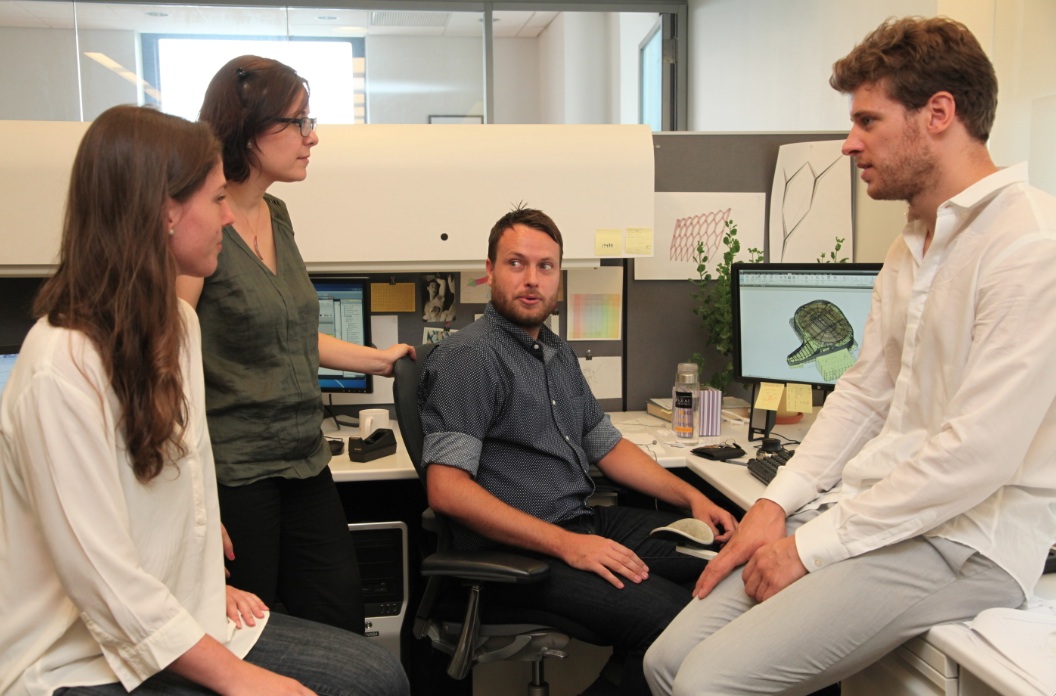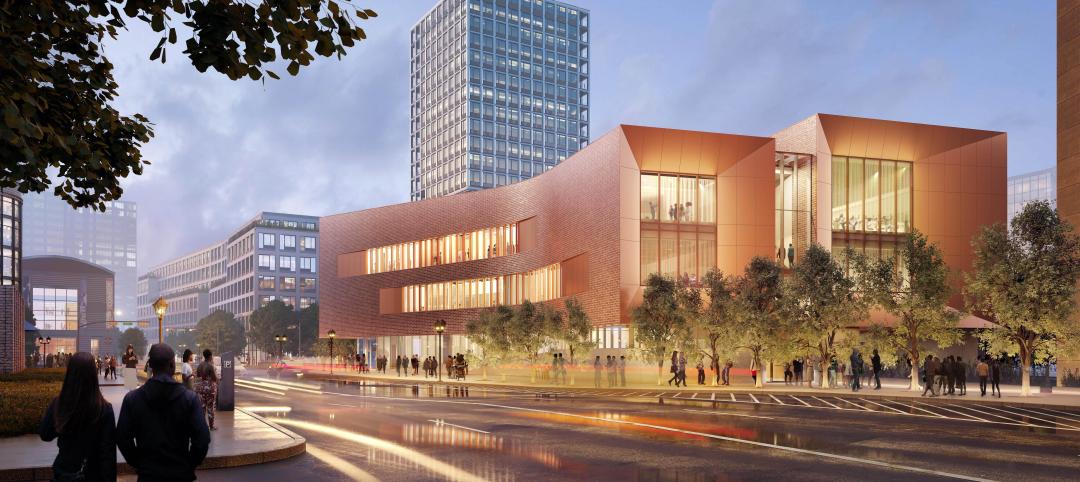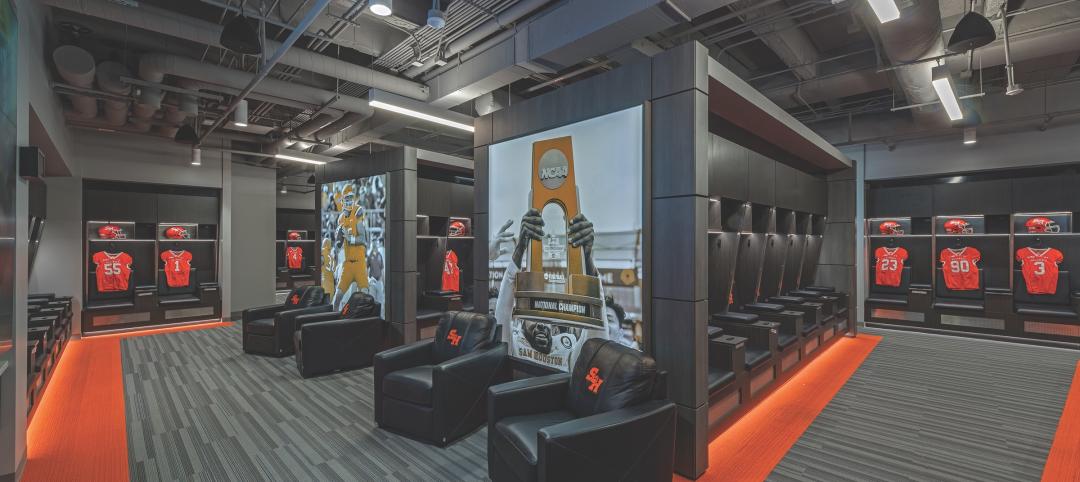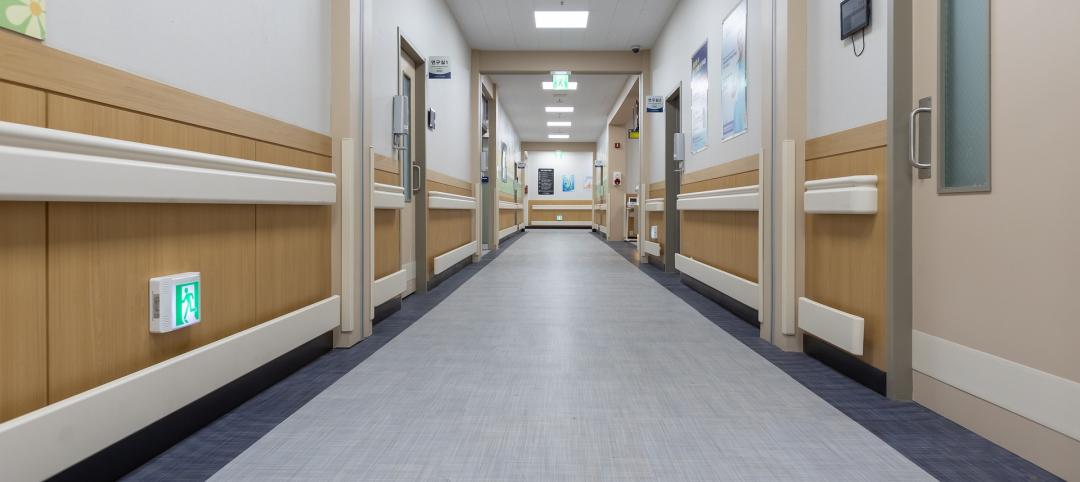As AEC firms dive deeper into BIM/VDC modeling and simulation workflows, the number of software tools put into play on a given project keeps growing exponentially. Firms recognize the value of implementing a mix of digital modeling tools, but the language barrier that exists between the different software platforms leads to tremendous waste and inefficiencies during the design and construction cycles.
Without the free and rapid exchange of data from the earliest stages of design through construction, Building Teams are forced to perform double work, such as manually inputting data and rebuilding early conceptual design models in a BIM platform. They also miss out on the potential of iterative design, where, for example, the results from daylight and energy modeling simulations can be fed back to the design team so it can make more-informed design decisions.
What is inadequate interoperability costing Building Teams? The most recent research—a NIST study published a decade ago (http://tinyurl.com/NISTsoftwareReport)—put the cost burden to the construction industry at $15.8 billion annually.
“When you look at the cost burden from a project budget perspective, interoperability accounts for 2-3% of the total construction budget,” says Nathan Miller, Associate Partner with BIM consulting firm CASE. “Just making a dent in that small percentage can yield a ton of benefits downstream.”
Firms are itching for interoperability solutions to establish data pipelines between software platforms and streamline workflows. This demand has led to growth in the emerging field of computational scripting, where firms develop (or commission third-party consultants like CASE to create) custom “hacks” that link digital tools and automate, accelerate, or eliminate wasteful processes.
“There are huge advantages to leveraging computational scripting and the broader concept of being able to customize your applications,” says Miller. “As a core capability, you’re going to see a greater need and desire among AEC firms to develop this skill set in-house, or have access to consulting firms like CASE.”
BD+C profiles two recent computational scripting projects that are making waves across the broader industry: Thornton Tomasetti’s TTX platform and CASE’s Rhynamo application.
THORNTON TOMASETTI’S TTX PLATFORM LINKS SIX DESIGN PLATFORMS
When structural engineering giant Thornton Tomasetti launched its in-house computational modeling and R&D incubator, CORE Studio, in 2011, one of its first objectives was to solve the BIM/VDC software language gap. At a minimum, the firm’s staff uses six primary design and modeling tools, none of which speak the same language. Incompatibility was costing Thornton Tomasetti thousands of staff hours annually by requiring its engineering teams to manually transfer project data from one design tool to another. It also impeded the exchange of data between team members during the design and construction cycles.
In the past, the firm had employed and tested a range of tools to translate project data from one platform to another, including IFC models and a suite of custom translators developed in house. But none of the solutions provided the ability to update and sync project models across multiple software platforms in real time, nor did they allow past versions of a model to be retrieved for analysis. These translators essentially performed “whole hog” imports that would completely overwrite the previous version, according to Benjamin Howes, Architect and Computational Designer with Thornton Tomasetti. “For example, if a draftsperson had been tagging and adding annotations to a Revit model and the model needed to be updated via a translation, all of the tagging and element-specific annotations would need to be redone.”
The firm’s solution was to make its design workflow software-agnostic by moving all critical project data into a custom database called TTX. More than two years in the making, the TTX platform provides real-time read, write, and sync capabilities across six software tools: ETABS, Grasshopper for Rhino, RAM Structural System, Revit, SAP 2000, and Tekla.
Using any one of these applications, Thornton Tomasetti’s engineers can “check out” the latest data on their project from TTX, work on the design and documentation, and then “check in” the updated version.
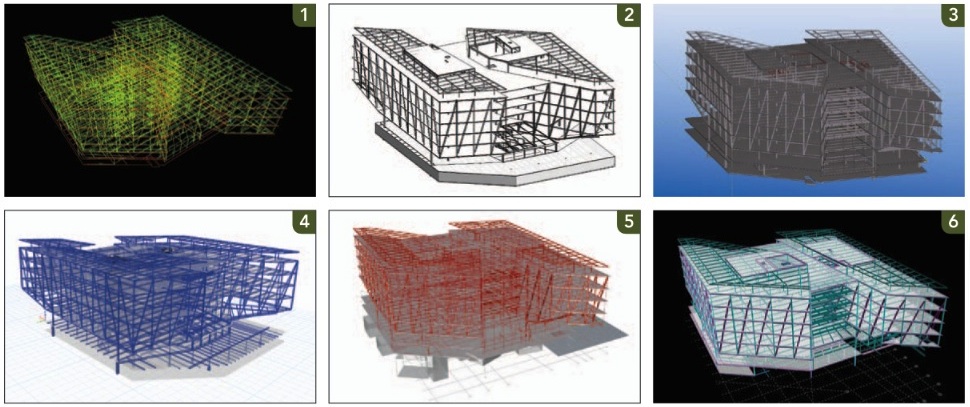
CORE Studio’s most prominent project to date is the TTX platform, a custom database that serves as the central repository for all of Thornton Tomasetti’s project data. Using TTX, the firm’s engineers can work on project models in any one of six software tools. Shown above is a project model displayed in all six software platforms supported by TTX: 1) SAP 2000, 2) Revit, 3) Tekla, 4) ETABS, 5) Grasshopper for Rhino, and 6) RAM Structural Systems. Screen shots: courtesy Thornton Tomasetti
“We may have 20 people working on any given project,” says Jonatan Schumacher, Director of CORE Studio. “It’s very difficult to coordinate between all team members. TTX serves as the coordination piece. Someone who’s been working on one platform can essentially update the database, and then the next morning everyone can checkout the latest data from the database and work in their respective modeling platform.”
Since the beta release of TTX in July 2013, more than 100 of the firm’s projects have been moved to the database, and nearly 12,000 data check-outs/check-ins have been executed. The firm currently has 95 regular TTX users. It also employs two full-time staff members to maintain the database, track updates to the major software platforms, and create custom tools for TTX.
“One tool we’re developing will allow us to easily compare two versions of the same database side by side,” says Robert K. Otani, PE, LEED AP, Principal with Thornton Tomasetti. “The first thing that any client wants to know is: What changes were made from the last issuance to this issuance? This tool will allow our teams to search for and highlight any change or series of changes, in real time. It’s going to be a huge time-saver.”
CORE Studio is also working on a Web-based dashboard for TTX that will allow clients and team members to view models remotely using any browser or device. “It’s essentially a lightweight version of a BIM model viewer, where users can spin around in the model, zoom in and out, and hover over elements to reveal the design attributes,” says Schumacher.
For more on TTX, visit www.ThorntonTomasetti.com/blog/post/43-Announcing-TTX.
RHYNAMO CREATES DATA BRIDGE BETWEEN REVIT AND RHINO
What started out as a nights and weekends coding project for CASE’s Miller has turned into one of the BIM consulting firm’s more exciting endeavors. Aptly named Rhynamo, the custom application serves as a bridge, linking two heavily used 3D modeling platforms—Rhino/Grasshopper for conceptual modeling and Autodesk Revit for BIM modeling—utilizing the open-source Dynamo graphical programming interface as the go-between.
Rhynamo offers AEC firms the ability to bypass the excruciatingly time-consuming process of rebuilding from scratch early conceptual Rhino models in the Revit platform.
With a few keystrokes, vital project data embedded in a Rhino model, such as geometries, coordinates, design parameters, and massing, cam be automatically imported into Dynamo, which can then be used “to build all sorts of systems on top of the BIM framework that Revit offers,” according to Miller.
“What Rhynamo does is provide a series of visual scripting nodes for Dynamo that allow a user to bring into Dynamo just about any geometric piece and different parts of data that are embedded inside a Rhino file,” says Miller. “That may involve translating geometry or using Rhynamo to coordinate parameters that might have been developed inside the Rhino environment—or simply providing an overall assist with that pipeline.”
In this YouTube video, CASE's Nathan Miller demonstrates the Rhynamo script.
Besides speed gains (which are difficult to measure, says Miller, since any time gained will likely be allotted for additional design work), Rhynamo offers Building Teams the opportunity for rapid iteration to occur throughout the design cycle.
“Instead of having to stop design at a certain point because the project deadline is looming, this seamless connection between design and production software allows design teams to move decisions further downstream and adapt to the changing conditions of a project much quicker,” says Miller.
“Design never stops,” he says. “When construction documents hit there are always going to be decisions that need to be made and studies to be done. Rhynamo is attempting to make the process as defined and efficient as possible.”
In less than three months since CASE launched a private beta test of Rhynamo, more than 300 BIM power users have downloaded the code for review. In the coming months, the firm plans to release the program as a free, open-source product, which will allow other firms to customize the code for their operations.
HDR and RTKL, two of CASE’s regular clients, are among the early adopters of Rhynamo. Others include a major retailer that used the tool to migrate its library of 2D drawings to Revit in order to automate the creation of 3D BIM elements.
“We were able to translate from 2D drawing to a coarse 3D Revit model in seconds,” says Miller. “Interoperability technologies allow us to leverage data in new ways across many platforms.”
For more on Rhynamo, visit: http://content.case-inc.com/rhynamo.
Related Stories
Adaptive Reuse | Oct 22, 2024
Adaptive reuse project transforms 1840s-era mill building into rental housing
A recently opened multifamily property in Lawrence, Mass., is an adaptive reuse of an 1840s-era mill building. Stone Mill Lofts is one of the first all-electric mixed-income multifamily properties in Massachusetts. The all-electric building meets ambitious modern energy codes and stringent National Park Service historic preservation guidelines.
MFPRO+ News | Oct 22, 2024
Project financing tempers robust demand for multifamily housing
AEC Giants with multifamily practices report that the sector has been struggling over the past year, despite the high demand for housing, especially affordable products.
Performing Arts Centers | Oct 21, 2024
The New Jersey Performing Arts Center breaks ground on $336 million redevelopment of its 12-acre campus
In Newark, N.J., the New Jersey Performing Arts Center (NJPAC) has broken grown on the three-year, $336 million redevelopment of its 12-acre campus. The project will provide downtown Newark 350 mixed-income residential units, along with shops, restaurants, outdoor gathering spaces, and an education and community center with professional rehearsal spaces.
Office Buildings | Oct 21, 2024
3 surprises impacting the return to the office
This blog series exploring Gensler's Workplace Survey shows the top three surprises uncovered in the return to the office.
Healthcare Facilities | Oct 18, 2024
7 design lessons for future-proofing academic medical centers
HOK’s Paul Strohm and Scott Rawlings and Indiana University Health’s Jim Mladucky share strategies for planning and designing academic medical centers that remain impactful for generations to come.
Sports and Recreational Facilities | Oct 17, 2024
In the NIL era, colleges and universities are stepping up their sports facilities game
NIL policies have raised expectations among student-athletes about the quality of sports training and performing facilities, in ways that present new opportunities for AEC firms.
Codes and Standards | Oct 17, 2024
Austin, Texas, adopts AI-driven building permit software
After a successful pilot program, Austin has adopted AI-driven building permit software to speed up the building permitting process.
Resiliency | Oct 17, 2024
U.S. is reducing floodplain development in most areas
The perception that the U.S. has not been able to curb development in flood-prone areas is mostly inaccurate, according to new research from climate adaptation experts. A national survey of floodplain development between 2001 and 2019 found that fewer structures were built in floodplains than might be expected if cities were building at random.
Seismic Design | Oct 17, 2024
Calif. governor signs limited extension to hospital seismic retrofit mandate
Some California hospitals will have three additional years to comply with the state’s seismic retrofit mandate, after Gov. Gavin Newsom signed a bill extending the 2030 deadline.
MFPRO+ News | Oct 16, 2024
One-third of young adults say hurricanes like Helene and Milton will impact where they choose to live
Nearly one-third of U.S. residents between 18 and 34 years old say they are reconsidering where they want to move after seeing the damage wrought by Hurricane Helene, according to a Redfin report. About 15% of those over age 35 echoed their younger cohort’s sentiment.


